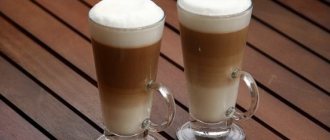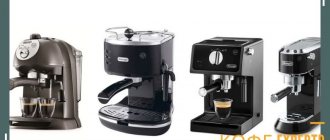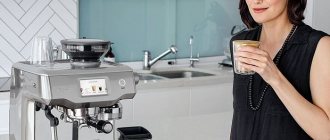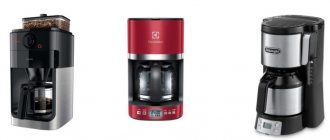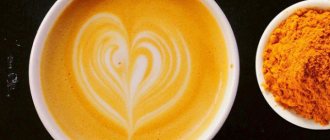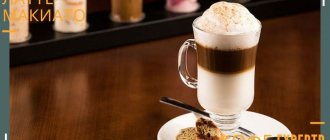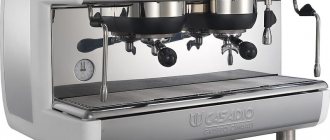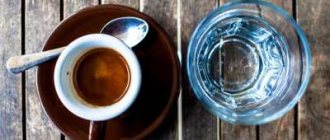Latte is one of the most popular coffee recipes. Fans of coffee cocktails love it for its large volume, low strength, soft creamy taste and the ability to experiment with toppings. There are several types of dishes to serve this drink - a cup, a glass and a latte glass. What are the distinctive features of each type, how to choose the right one and what price will the purchase cost?
What is the correct name for a latte glass?
A specific name is not given, since even the origin of the drink is not entirely accurate. Moreover, various types of containers are used for serving coffee:
- glasses;
- glasses;
- mugs;
- cups.
Fans of coffee cocktails love lattes for their large volume, low strength, soft creamy taste and the opportunity to experiment with toppings.
Each of them allows the barista’s imagination to run wild and surprise the client with something unusual.
There are several types of dishes to serve this drink - a cup, a glass and a latte glass.
Why are lattes served in special glasses?
Unfortunately, there are too many inaccuracies to answer the question about the origin of serving this coffee drink. The name deserves special attention - “Latte” - in Italy this was the name for milk served in tall glass glasses. Coffee itself is now served in the same way. Further, according to the history of the drink, they began to add a portion of espresso to the latte milk (instead of topping), and this is how this type of coffee turned out. However, in its homeland it is called latte macchiato or coffee milk translated into Russian.
As with many coffee stories and recipes, the origins and presentation of the latte have many inaccuracies.
Foam appeared even later - with the advent of cappuccino makers. Initially there was none.
Latte is Italian for milk, served in tall glass glasses.
Additional information: baristas quickly noticed that when pouring coffee into milk after whipping the foam, the latter remained under it. Thanks to this, the drink acquired the form known to all of us.
As an experiment, Italian bartenders began adding a shot of espresso coffee to milk as a topping.
Today, latte macchiato glasses are a pleasant continuation of the traditions of the past. Preference is given to clearly distinguishable layers - aesthetically it looks much more beautiful, especially if the drink is additionally sprinkled with chocolate chips or cinnamon.
Baristas noted that if a shot of espresso is poured into milk in a special way immediately after whipping, the coffee gets under the light and loose foam, forming a dark layer.
The history of latte
It all started with Italian housewives, who are distinguished by their intelligence. To please all family members and their varied tastes, they came up with a layered drink. Adults appreciated the thick and aromatic coffee, children enjoyed the airy foam, and due to the lower layer of milk, the caffeine level was reduced, and the latte became safe for health. Later, the new invention began to be prepared in cafes, since the drink is visually attractive due to its delimited layers.
Reference. The name “latte” was also not given by chance, because from Italian this word is translated as “stained milk”.
Many people argue about how to pronounce this word correctly. The Italians themselves say latte with the emphasis on the first syllable. You can pronounce it however you want, because it doesn’t matter, the main thing here is the taste and quality of the drink.
Main characteristics of latte glasses
Glasses, glasses, cups and mugs have approximately the same volume:
- first: from 150 to 300 milliliters;
- second: from 250 to 300 milliliters;
- third: from 250 to 320 milliliters;
- fourth: from 300 to 360 milliliters.
The tradition of serving lattes in glass glasses has continued.
Glasses differ from others not only in their practically fixed volume, but also in the absence of a handle. In this regard, it becomes important to serve the drink at a certain temperature so that the person drinking it does not burn his hand.
To this day, many establishments continue to prepare lattes so that the layers of the drink are clearly visible.
The design varies. It all depends on the barista’s imagination.
Today, the choice of containers for latte is very large.
How to choose coffee
The key to a tasty and healthy drink is properly selected high-quality raw materials. Therefore, first of all, you need to learn how to choose the right coffee beans. By the way, ground coffee is also suitable - the main thing is that it is natural coffee and not instant powder. But we’ll talk about the choice between ground and bean coffee a little later, but now let’s figure out how to choose good coffee by type.
Coffee varieties
There are about two hundred varieties of the drink, but don’t be scared
For now, we’ll leave the subtleties to the experts, but what’s important to us is that there are only two main varieties: Robusta and Arabica
- Arabica: a less strong drink, with a sour taste.
- Robusta: a more invigorating drink due to its high caffeine content, with a slightly bitter taste.
If you are new to the world of coffee wisdom, you can limit yourself to this for now. But real coffee lovers know that in reality there are hundreds of shades of taste: it all depends on where exactly the beans grew. Moreover, everything affects the result, from the climate of the country to the bushes that grew near the coffee plantation. This is why African Arabica will taste completely different than South American Arabica. Moreover, African Arabica from one plantation will be different from a drink made from beans from a neighboring one.
Therefore, in order to get a complete picture, it is important to look not only at the variety, but also at the country of origin, city and mountain where the coffee grows. Even the port from which the grains were sent to another continent matters!
Advice
. If you're not yet a seasoned coffee connoisseur, try a few types before purchasing beans. Choose coffee not in a supermarket, but in a specialized store or coffee shop: there you can taste several types of drink, and then take the beans of the coffee you like best. After several such purchases, you will have a better understanding of what you like and learn to choose by the name on the pack.
So, the subtleties of taste depend on the specific plantation, but it is still possible to identify certain patterns across countries.
- Brazilian coffee has a rich taste, it is strong, tart, with nutty notes.
- Colombian will appeal to lovers of a sour drink. The taste is very balanced, velvety.
- Coffee from Costa Rica is especially aromatic and dense.
- Guatemalan coffee has a very special bouquet, the components of which are flowers, spices and chocolate.
- Chocolate notes also shine through in Indian coffee, but it is noticeably stronger.
- Bitterness and berry notes are the hallmark of the Ethiopian drink.
- Kenyan coffee is for everyone: with the aroma of berries and a wine flavor, a drink with sourness.
Why do you need a DeLonghi glass?
DeLonghi glasses are distinguished by the presence of double glass, so even drinking fairly hot espresso will not cause discomfort. We're not talking about latte at all.
Luxurious, spacious and branded - that's what they are all about.
The glass can also accommodate double espresso; larger models are rarely found.
Espresso glasses are commonly referred to as double-walled glass containers.
Types of tableware for latte coffee
Thanks to the human desire to stand out, not only different serving methods, but also types of containers began to be used for the drink. Each of them opens up new scope to surprise the client.
Over time, other interesting serving options for this recipe have appeared.
Drawing, topping, topping, natural berries - these are just the bare minimum of design elements for this coffee.
The choice of glassware for drinking it depends on the type of drink and your preferences.
Latte glass
One of the classic options most often found in establishments. The volume depends on the personal wishes of the client or is set in the menu. From 150 to 300 milliliters (standard).
Made of glass, has a volume from 150 to 300 ml, equipped with a handle.
There are two types of glasses:
- With a middle leg. The bowl expands from bottom to top. Has a smaller volume.
- With a short leg. Standard size for 300 ml containers. There is a pen.
There are two main types. On a short stem, similar to an enlarged glass and a regular one, reminiscent of a glass cup.
All coffee glasses are transparent. The drinker should see smooth transitions from milky white to coffee brown and back.
Latte glass
The main difference from the previous type of container is the absence of a handle. Volume 250-300 milliliters. Often served on a saucer.
It is distinguished by the absence of a handle. Its volume ranges from 250 to 300 ml.
Latte cup
A cup is a separate type of tableware. Laconic inverted trapezoid shape, comfortable handle. Opaque. Preference for cup colors is white, cream and vanilla.
Most often it has the classic colors of coffee utensils - white, cream, vanilla.
Often sold complete with a small saucer and small spoon. Volume up to 320 milliliters, larger specimens are rarely found.
Latte mug
Thick-walled porcelain or ceramics are the main materials used in the manufacture of mugs. Quite heavy, somewhat rough for a delicate drink, which partly complements it.
Latte mugs can be straight-sided or tapered at the bottom.
It is distinguished by increased reliability and some comfort created by peace of mind.
They do not pretend to be graceful; they are often decorated with cute designs or various ornaments.
It’s difficult to call mugs elegant, but cute designs and various ornaments more than compensate for this. Volume up to 360 milliliters.
What type of coffee requires cups?
Strong coffee
The stronger your favorite recipe, the smaller the volume of the dishes should be. Gourmets who most like to pamper themselves with a cup of strong black coffee brewed by hand or a shot of scalding espresso from an automatic coffee maker can choose cups up to 100 ml.
We recommend paying attention to demitasse cups, which are ideal for revealing the bouquet of natural freshly brewed coffee. They have the right volume and laconic shape
Coffee drinks
If you drink coffee in large portions or prefer to dilute the drink with milk, cream, or toppings, then feel free to choose large and cozy cups of 200-300 ml.
Despite the temptation to buy a coffee cup made of thin porcelain, it is better to give preference to dishes with thick walls. In this case, the drink will retain its bouquet of taste and aroma much longer.
How to choose latte glassware
The correct choice of glassware for drinking a particular drink is of certain importance. So, giving preference to a glass, mug or cup, you should understand the following:
- they have different characteristics;
- has its own characteristics;
- different taste of the drink.
Today, transparent dishes are gradually being replaced by tall cups and mugs.
Most rely on aesthetic pleasure. After all, drinking a coffee drink is much more pleasant, at least from a mug with the inscription “Coffee”.
The real taste of latte macchiato is revealed only when the drink is smooth.
It is important to know: even in professional establishments, transparent containers are gradually fading into the background; tall cups and mugs are becoming more and more common.
Why? Everything is extremely simple!
- The revelation of real, full taste and aroma is possible when the drink reaches a homogeneous mass. The barista should pour the espresso in such a way that the mixing is maximum.
Glass is inferior to opaque materials due to the immediate loss of aesthetic appearance.
- Porcelain retains the original temperature of the drink much longer, which is important for establishments. Therefore, preference is increasingly given to thick-walled cups and mugs.
- The versatility of ceramic mugs. Suitable for tea, Americano, latte and other drinks.
A good barista will try to pour the espresso into the frothed milk to ensure maximum mixing of the ingredients.
Thus, transparent coffee glasses are gradually beginning to lose their former popularity. Establishments want to optimize costs, customers of coffee shops and cafes want to get maximum pleasure from drinking a coffee drink.
At the barista championship, lattes are evaluated, among other things, by the uniformity of taste. The layered structure is considered bad form for connoisseurs.
How is the drink served?
Before moving on to the rules for drinking latte coffee, you need to familiarize yourself with the features of its serving. The dish is prepared and served in special Irish glasses. These are transparent glass containers for drinks such as cappuccino and latte. This way the client or guest will be able to see all the layers of coffee and milk.
Serving in porcelain cups is also acceptable. But they are much wider and higher than usual, since the drink is usually drunk in large portions.
Cinnamon, grated chocolate or vanilla are sprinkled on top of the milk foam. It is acceptable to pour syrup, but when using it, consider the taste of the latte, since not every ingredient can be combined with it. So, fruit syrup can ruin a coffee drink. It will acquire a bitter taste. A similar reaction occurs when citrus syrups are added. They speed up the process of milk souring, so they are not added to lattes. But chocolate or vanilla syrup would be nice. You can also add blackcurrant syrup to the drink; it also goes well with coffee and milk.
Note! Traditionally, lattes are served without sugar, but you still need to focus on the person’s taste. You can sweeten the drink, but according to the rules, it is only topped with chocolate or vanilla syrup.
The ideal combination of coffee and milk in a latte: 1 part coffee and 3 parts milk. The basis of this drink is:
- espresso;
- hot milk, just hot, but not boiling;
- and frothed milk.

